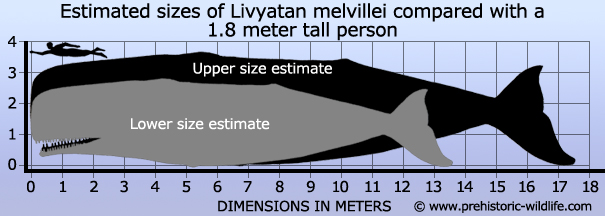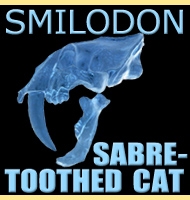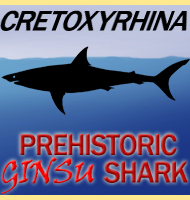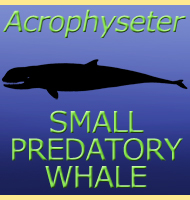


Livyatan

Name: Livyatan
(Leviathan).
Phonetic: Liv-ya-tan.
Named By: Lambert et al. - 2010.
Synonym: Leviathan melvillei.
Classification: Chordata, Mammalia, Cetacea,
Physeteroidea.
Species: L. melvillei (type).
Diet: Carnivore.
Size: Skull is 3 meters long. Total size
estimates vary between 13.5 and 17.5 meters long.
Known locations: First known from Peru - Pisco
Formation. Confirmed remains from Argentina also known. Teeth probably
attributable to the genus also reported from South Africa.
Time period: Serravallian stage of the Miocene of
the Neogene.
Fossil representation: Partial preserved skull,
mandible (lower jaw) and teeth.
When
first described the prehistoric whale Livyatan was
actually named
Leviathan after the
biblical sea monster. Unfortunately however Leviathan had already
been used to name a mastodon now known as Mammut
(Leviathan is
actually a synonym to this genus, but still cannot be used). As
such the Hebrew word for Leviathan, Livyatan,
is now used to refer
to this ancient whale. The species name, L. melvillei
is in
honour of the author Herman Melville, the man who wrote the world
famous novel 'Moby Dick'.
Because
only the skull is known, Livyatan is often
compared to the sperm
whale (Physeter macrocephalus) when piecing
together the rest of
the body. This has yielded size estimates of thirteen and a half
meters which make Livyatan a comparable size to the
megatoothed sharks
like Carcharocles
angustidens. However Livyatan
has also been
compared to another prehistoric whale named Zygophyseter,
and this
resulted in an estimate of seventeen and a half meters. If accurate
then this would make Livyatan comparable to even C.
megalodon, the
largest shark to ever swim the ocean. In fact for a time both
Livyatan and C. megalodon
would have swam in the same oceans.
Not
only was Livyatan an apex predator like C.
megalodon, it probably
fed upon the same prey animals which were medium sized baleen whales.
Smaller juvenile Livyatan may have preferred
proportionately smaller
prey items like the smaller cetaceans or even large fish. With teeth
that were thirty-six centimetres long, Livyatan
had the dentition to
take down large prey items. In fact not only were the teeth of
Livyatan considerably larger than C.
megalodon
teeth, they are
considered to be the largest known teeth for the purpose of eating.
Granted some animals like elephant have modified teeth that form tusks
which are even bigger, but they are useless for processing food in
the mouth so in
this case they do not count as the largest. Livyatan
also had teeth
in both the upper and lower jaws for grasping prey (the modern sperm
whale, the closest living analogy to Livyatan,
only has teeth on
the lower jaw).
How
Livyatan hunted it still a matter of debate, but
given its large
mouth and teeth it may have used a similar method to kill smaller
whales as C. megalodon did. This could be
approaching from the
bottom and slamming into its target from underneath. An associated
method could also be trapping the smaller whale’s rib cage in its jaws
and crushing the ribs to create fatal injuries to the internal organs.
Another method could see Livyatan holding down a
whale beneath the
surface to stop it surfacing for air. This is a strategy that would
be potentially risky for Livyatan as it too would
still need to surface
to breathe air, but assuming Livyatan could hold
its breath for
longer than its prey, it would still be a viable strategy.
Livyatan
is morphologically similar to the modern sperm whale, and this has
brought comparisons between the two for head function. Livyatan
is
thought to have had a spermaceti organ that would have been filled with
wax and oil. This has also inferred the possibility that Livyatan
may
have used echolocation to find its prey.
Further reading
- Corrigendum: The giant bite of a new raptorial sperm whale from the
Miocene epoch of Peru. - Nature 466:1134. - O. Lambert, G. Bianucci, K.
Post, C. Muizon, R. Salas-Gismondi, M. Urbina & J. Reumer -
2010.
- Distribution of fossil marine vertebrates in Cerro Colorado, the type
locality of the giant raptorial sperm whale Livyatan melvillei
(Miocene, Pisco Formation, Peru). - Journal of Maps. 12 (3): 543. - G.
Bianucci, C. Di Celma, W. Landini, K. Post, C. Tinelli & C. de
Muizon - 2015.
- First record of a macroraptorial sperm whale (Cetacea, Physeteroidea)
from the Miocene of Argentina. - Revista Brasileira de Paleontologia.
21 (3): 276–280. - David Sebasti�n Piazza, Federico Lisandro Agnolin
& Sergio Lucero - 2018.
- Early Pliocene fossil cetaceans from Hondeklip Bay, Namaqualand,
South Africa. - Historical Biology: 1–20. - R. Govender - 2019.
Random favourites
 |
 |
 |
 |




